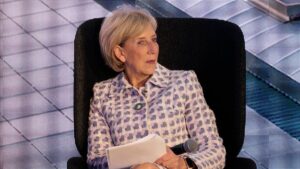Can mineral sands and rare earths help Victoria revive its reputation as a mining state?

Picture: Getty Images
- Victoria’s mineral sands players remain confident the state will be home to a new rare earths industry
- Australia currently produces around 9% of mined rare earths, but virtually all processing is done in China
- ACDC Metals executive director Mark Saxon says the critical minerals can help revive Victoria’s reputation as a mining state
Despite the historical challenges that have faced mining in Victoria, a big player in the local rare earths industry thinks the state can become a major player in the electric vehicle and renewables transition as more companies seek permission to dig up mineral sands littered with the critical minerals.
Microcap ACDC Metals (ASX:ADC) is one of a number of companies with permits in the Murray Basin, where Rio Tinto’s (ASX:RIO) CRA exploration arm discovered the fine-grained mineral sands deposits that could revive mining activity in the gold rush state in the 1980s.
Executive director Mark Saxon says processing methods did not exist for those deposits back in the late 20th century, but they do now.
ACDC plans to deliver a maiden resource this quarter with a scoping study on its Goschen Central project 50km from Swan Hill in northwest Victoria due later this year.
With rare earth minerals in high demand — despite the impact of China’s quotas and economy on rare earth prices this year — Saxon said Victoria was well placed to revive its long-lost reputation as a mining heartland.
“I think it’s been 15 or 16 years since the last mine has been opened. So we’ve kind of lost that culture, I suppose, in terms of mining,” Saxon said.
“But a lot of the gold mining that has attempted to be permitted in the past sits in sort of southern and central Victoria where it does have impact on competing land use — Bendigo, Ballarat, Castlemaine kind of areas where there’s been some difficult permitting stories.
“If we look at the mineral sands, they’re sitting out in the plains of the Wimmera Mallee. Absolutely good agricultural land, but reasonably low value use and reasonably low population.
“So there’s a much better opportunity to do work up there and and permit a mine.
“One of the companies called Wim Resource has done a really great job on doing a trial test pit, and then doing full rehabilitation. That went extremely well and showed that the mineral sands can be mined, the topsoil can be replaced and the agricultural value of the land essentially doesn’t change over that period.”
National importance
The owner of another of those mineral sands deposits, Iluka Resources (ASX:ILU) has taken the first step in making Australia a competitor to China in rare earths products by beginning the construction of a refinery to produce NdPr and more from a multi-billion dollar waste stockpile of monazite historically mined at its Eneabba operation in WA.
Located near Geraldton, the plant has already received significant government support in the form of a $1.25 billion loan from Canberra, with a $15 million study now signed off to see if Iluka can extend further from producing rare earth oxides to metals onshore in Australia.
Steps beyond that include the production of magnets for EV motors and wind turbines, the vast bulk of which is done in China.
“This is the most exciting thing that’s happened in the industry, probably ever … to see that stockpile they’ve been accumulating since 1975, can be turned into value,” Saxon thinks.
“It’s really great that we can process that in Australia and not send it to China for processing so a big tick which got money coming from the Australian Government. I don’t think it needs it economically.
“But that’s a great buffer I suppose to show that it’s real and it’s important for Australia and that it’s valuable to have that material processed in Australia.”
He hopes government agencies see the role Western Victoria will play in supplying that refinery or developing new ones like it on the east coast.
“It’s important tthat Victoria, and perhaps even the Federal Government recognises the significance of what’s sitting out there in Western Victoria,” Saxon said.
“We’ve got 100 years of mining out there, that can be a very major producer of lots of metas, so I think it’s got to get that priority and status that it is very important for Australia, and particularly eastern Australia.
“Victoria has to speed up its permitting process, and adequately resource the permitting authorities to make sure that the the right people are in the right place to make the right decisions.”
Value add
Victoria is best known for a handful of high grade gold mines like the legendary Fosterville operations. But there are a number of explorers and developers there moving into the mineral sands and rare earths sector, with a cadre of companies on the ASX focusing on the area around Swan Hill.
Outside of ACDC and Iluka, the more advanced VHM (ASX:VHM) and Astron Corporation (ASX:ATR) have already delivered definitive feasibility studies for their Goschen and Donald projects.
$77 million capped VHM, which includes Mineral Resources (ASX:MIN) boss Chris Ellison among its register, updated its latest study in March.
It says the project could generate $270 million in cash each year over its first decade, generating an internal rate of return of 44%.
A 5Mtpa plant would produce a mix of zircon-titania heavy mineral concentrate, rare earth concentre and mixed rare earth carbonate. It hopes to begin construction next year.
At Donald, Astron hope to be shipping from the more than four-decade long project from the third quarter of 2025.
It promotes Donald as the world’s third largest rare earth resource outside China and largest zircon resource globally, with around 58% of its revenue expected to be generated from high value rare earths.
NdPr prices are sitting around US$72/kg, well below the highs seen in early 2022, while major market player Lynas (ASX:LYC) has stockpiled some non-contracted material in the hope of securing higher prices down the line.
China has a high degree of control over the market and pricing, one of the reasons Western nations are keen to invest in companies with resources in the hope of building downstream processing and eventually a whole supply chain that is not reliant on the battery metals powerhouse.
While China controls 60% of rare earth oxide mining (13% is in the US, 11% in neighbouring Myanmar and 9% in Australia) that increases to 87% when it comes to oxide processing, 91% for metals and 94% for permanent magnets, where only Japan can otherwise lay claim to producing at any sense of scale.
Saxon says ACDC is looking at value-adding opportunities as part of its Goschen Central project, though that is a bit of the way down the line.
But he said customers were looking actively for opportunities to find supply outside China.
“No one’s ever going to say no to Chinese suppliers, and they’re too important, but the customers are all trying to build up Plan B and Plan C, which they didn’t really have to do before,” Saxon said.
“So that’s certainly happening. That’s going to be great for Western suppliers of rare earths and other critical materials as well. So I think that’s very positive.
“The fundamentals for the market are very positive. If you look at EVs and wind turbines, they’re much more efficient if they use rare earths.
“People want rare earths, engineers want to be using rare earths, just the price has to be right and the supply chain has to be secure to encourage engineers to engineer in rare earths, not engineer them out.”
Vic rare earths stocks share prices today
Related Topics

UNLOCK INSIGHTS
Discover the untold stories of emerging ASX stocks.
Daily news and expert analysis, it's free to subscribe.
By proceeding, you confirm you understand that we handle personal information in accordance with our Privacy Policy.








